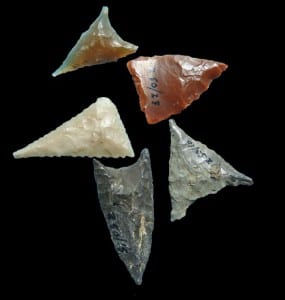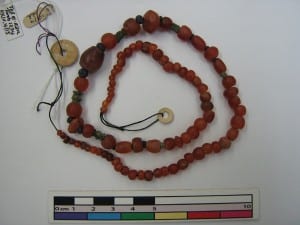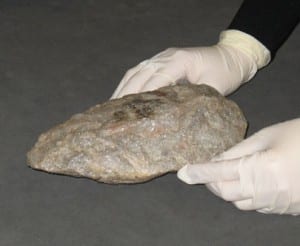The great zombie apocalypse
By Rachael Sparks, on 8 October 2013
On September 18th, UCL Museums and Collections participated in a worldwide event on Twitter: Ask a Curator day. The plan was to have a handful of curators on call to deal with questions as they flooded in from a curious public. The reality was that we didn’t have many queries sent directly to our feed, so we went out into the Twittersphere to seek out interesting questions to answer. As Keeper of the Institute of Archaeology Collections, I spent an hour manning the virtual desk, and found it an interesting experience.
There was a huge range of questions on offer (over 26,000 tweets in all), and it was difficult to keep track of them all. But there was certainly something for everyone, with questions being posed by as many museum professionals as members of the general public.
Wannabe curators were curious about our jobs: how did we get here? What essential qualities should a curator have – and its evil twin question: what qualities should NO curator have? What was the best thing about our job? And what was the worst?
Others were keen on a show and tell session: what is the biggest, best, scariest or funniest object that you have?
And a dedicated group of angry individuals were set to drive the British Museum team into a corner on the issue of the Elgin Marbles; when were they going to return them to Greece? (#Parthenonmarbles). This was met by a resounding silence, either because BM staff did not want to engage in what could easily become an acrimonious dispute, or because they were afraid to express an opinion that might go contrary to the official line on the issue.
Undoubtedly, though, the question of the day came from a curator at Dublin Museum during their lunchtime break, asking: ‘In case of a zombie attack, what object would you grab to ensure survival?’
Here was pause for thought, and a chance to think about disciplinary differences between different types of collections. What opportunities does an archaeological collection present for zombie defense? The weapons of antiquity have all become less effective through the depredations of time and the processes of use-wear, archaeological deposition and recovery. Corrosion of bronze and iron weapons has blunted edges and weakened the structure of the metal. Poke one into the yielding flesh of a zombie and it would probably break off in situ.
Chipped stone tools? These have retained their edges better, and obsidian is always a favourite for a killer edge, as any careless curator who has been handling lots of lithics will tell you. But your typical stone knife or arrowhead would have been originally hafted in some kind of organic material, perishable and now long gone. So what we have in our collections is just a part of a much more effective whole. You don’t want to get too close to a zombie; so a weapon with a long haft is infinitely preferable to a disembodied tool part.
Wrap a string of beads around its neck and pull tight? But our necklaces were strung a long time ago, and the strings would most probably break. While that might create a rolling carpet of beads, sufficient to trip up a zombie, experience tells me that a dropped bead will immediately roll under the most inaccessible item of furniture in the room.
Hurl sling stones and other suitably weighted groundstone tools? We lack the means of efficient propulsion, unless there is time to scramble up a safety ladder first. As all aficionados of the archaeological murder mystery genre know, dropping a stone quern from a great height can be very effective (Murder in Mesopotamia anyone?).
How about the tactics of confusion? Find a complete pot with a broad mouth and pop it over the zombie’s head, obscuring its vision and giving you time to make your escape? What type of pot would be best? An amphora is no good – the neck is too narrow. A pithos (that’s a large storage jar to the uninitiated) would be great, but these things are heavy, and even taking into account the slow wits and lurching movements of our undead friends, its unlikely you would have time to get it in place. Probably the best thing would be a holemouth cooking pot: broad aperture, thick walls and good thermal shock resistance (in case the head heats up once enclosed).
Unfortunately, I don’t have any such pots with head-sized apertures in my collection, no doubt due to the short-sightedness of my curatorial predecessors, who did not factor in the defensive capacity of vessels when setting up their acquisition policies.
Rapidly running out of archaeological resources, my thoughts turned to other UCL museum collections and their prospects. At first, I thought the Art Museum might have nothing to offer but paper cuts, but then realised he opportunities afforded by sculpture; both they and Geology must have a few heavy rocks to hand, although in differing stages of manipulation. The Grant Museum of Zoology has lots of pointy bones, and the sheer size and weight of their infamous walrus penis would cause any zombie to take pause.
But the best of all would have to be the Ethnography Collection. Anthropology, of course, has the whole package: ceremonial masks and exotic costumes to hide behind, combined with a full array of threatening and dangerous weapons in all their fully hafted and operational glory. Once you’ve had a chance to remove dust protective sheeting and disentangle any historic labels. You would, however, have to check your ethics at the door before subjecting culturally significant items to this sort of impromptu reuse.
So lets recap on the whole zombie situation. What do we know about zombies? They are slow moving, have poor body integrity, and show little capacity for intellectual cunning. Oh yes, and they are completely fictional.
In a real-life zombie apocalypse, a completely different scenario would play itself out. Faced with a wall of slowly advancing zombie warriors, our curatorial instincts would come to the fore, and we would drive them back with our mighty museum battle cry of: ‘Don’t touch that object! You’re not wearing any gloves’. That should save the day …
Rachael Sparks is Keeper of the UCL Institute of Archaeology Collections.
3 Responses to “The great zombie apocalypse”
- 1
-
3
Specimen of the Week: Week 152 | UCL UCL Museums & Collections Blog wrote on 8 September 2014:

[…] we’re fans of science fiction here at UCL Museums, from the Institute of Archaeology Keeper preparing for the zombie apocalypse, to the Petrie Museum attending LonCon and own film nights which often feature radioactive monsters, […]
 Close
Close






Hi Rachael. I can guarantee the Geology Collections have enough heavy rocks to keep the zombie hoards at bay for a while.
When the apocalypse comes I’ll make sure the Geology Store is open to everyone from UCL Museums, after they’ve had proper handling training obviously.